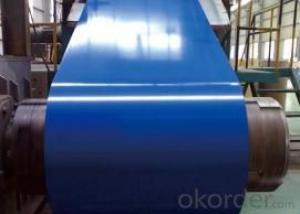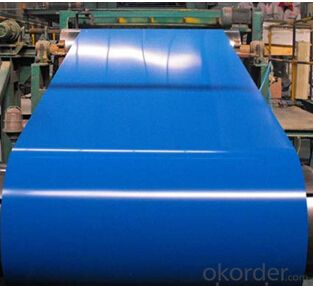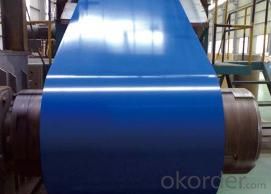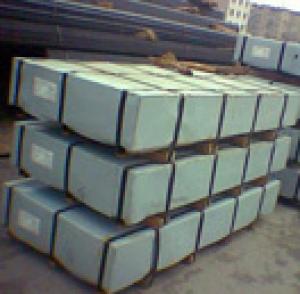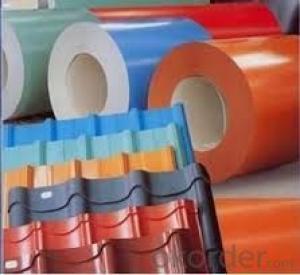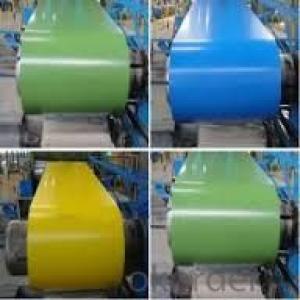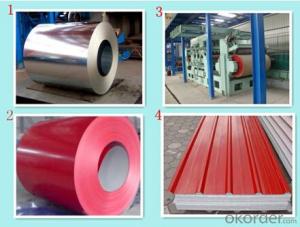Prepainted Corrugated Galvanized Steel Roofing Sheet/Color Coated Steel Coil
- Loading Port:
- Tianjin
- Payment Terms:
- TT OR LC
- Min Order Qty:
- 30 m.t.
- Supply Capability:
- 10000 m.t./month
OKorder Service Pledge
OKorder Financial Service
You Might Also Like
Description Info.
Model NO.:CUS-140226-K
Surface Treatment:Coated
Certification:ISO, SGS, BV
Technique:Cold Rolled
Standard:ASTM, JIS, GB, AISI, DIN
Application:Building Materials
Edge:Slit edge
Stock:Stock
Steel Grade:Q235
Color:Ral Colors(Blue,Red,Green etc.,)
Width:600-1250mm
Thickness:0.13-1.5mm
Zinc-Coating:60-275G/M2
Top Paint Layer:18-25um
Export Markets:Global
Additional Info.
Trademark:CUS-STEEL
Packing:Export Packing
Standard:0.13-1.5mm/600-1250mm
Origin:China
HS Code:7210
Production Capacity:150000 Mt/Year
Product Description
PPGI/Prepainted corrugated galvanized steel roofing sheet/Color Coated Steel Coil
Features: Excellent decorative, molding, corrosion resistance, strong coating adhesion, efficient construction, save energy and to prevent pollution and other good economic effect.
Application: Steel structure buildings, household appliance, furniture, transportation and other industries
Advantages of Our Prepainted Galvanized SteelCoil:
1) Excellent corrosion resistance: The zinc layer provides a good protection of Pre-painted Galvanizeed Steel Sheet.
2) High heat resistance: The reflective surface of the material aids in efficiently reflecting the sunlight away and in turn reducing the amount of heat transmitted. The thermal reflectivity converts into energy savings.
3) Aesthetics: Pre-Painted Galvanized steel sheet is available in plethora of patterns and multiple sizes as per the requirements that given by our customers.
4) Versatility: can be used in the various areas.
Applications of Prepainted Galvanized SteelCoil:
1) Buildings and constructions: roofing, ceilings, gutters, venting lines, indoor decorations, window frames, etc.
2) Electrical appliances: computer shells, washing machines, refrigerators, dehumidifiers, video recorders, water heaters, etc.
3) Agricultural equipments: troughs, feeding tools, agricultural driers, irrigation channels, etc.
4) Vehicle parts: back-seat plates of buses and trucks, conveying systems, oil tanks, etc.
Raw material | SGCC, SPCC, DC51D, SGHC,A653 |
Certificate | ISO9001.ISO14001.OHSAS18001 |
Thickness | 0.13mm-1.2mm |
Width | 600mm-1250mm |
Tolerance | thickness+/-0.01mm |
Surface treatment | galvanized / galvalumized steel sheets |
T Bending (top-coating) T Bending (back-coating) | ≤3T ≤4T |
Anti-MEK Wiping | ≥100times |
Zinc coating | 40-275g |
Type of coating process | Front: double coated & double drying Back: double coated & double drying, single-coated & double drying |
Coating types | Top paint: PVDF, HDP, SMP, PE, PU Primer paint: Polyurethane, Exoxy, PE Back paint: exoxy, modified polyester |
Color | customized |
Application | Buildings and constructions, Electrical appliances, Agricultural equipments, Vehicle parts |
FAQ
1.What's your MOQ?
25MT, it is for one container.
2.Do you have QC teams?
Yeah, sure, our QC team is very important, they will keep the quality control for our products.
3. What's your normal delivery time?
Our delivery time about 10-20days for standard sizes, if you have other requirements like hardness and width ,it is about 20-40days. But don't worry ,we also try our best for the delivery time ,because time longer and our cost is higher.
4.Are the products tested before shipping?
Yes, all of our PPGI and GI was qualified before shipping. We test every batch every day
- Q: All the appliances in my kitchen are stainless steel, and I hate how they look becuase every time I wash them they are full of streaks. Is there a good cleaner made for stainless steel that won't leave streaks?
- WD40 is great for cleaning stainless steel anything for some reason it protects it from finger prints things so you won't have to clean it as often. WD40 is great for thousands of other uses too, it can remove stickers, dried paint from glass, wipes away crayon wax, lubricates squeeky parts, spray it on your lawnmower or bike before you put it away for winter it'll come out in spring rust free.... so you'll get more than your moneys worth from a small tin.
- Q: Hello,is it possible to divide an alloy in its own elements? I am particularly interested in Stainless Steel, which is made of Nickel, Chrome and Iron. Do you have an idea of where can I find some more information (blogs, reviews, sites or books)?Thanks for your help
- Yes it is possible to recover individual elements from an alloy such as stainless steel, but not easy. Look up etching of stainless steel on google. This same etching solution will completely dissolve stainless steel. These solutions are strong acids such as H2SO4 and HNO3 so safety goggles and good ventilation are absolutely required. Once the metal has been dissolved, then you would need to use a qualitative analysis scheme to precipitate out the different metals one at a time as compounds, then do additional reactions to recover the metallic elements.
- Q: Im going to buy T-304 Stainless Steel exhaust tips for my truck. Is T-304 Stainless Steel good metal?
- Surprisingly any stainless steel is considered soft or tough metal. A hardness tester will bare this out. It resists work hardening which means you can bend it many more times than cold rolled or hot rolled steel before it will break. Your choice is a good one for your intended purpose.
- Q: How are steel coils used in the production of steel handles?
- Steel coils are used in the production of steel handles by being processed and shaped into the desired handle design. The coils are uncoiled and fed into a machine where they are cut, bent, and formed to create the handle shape. The coils provide the raw material needed for the manufacturing process, ensuring the handles are strong, durable, and able to withstand the required usage.
- Q: How do steel coils contribute to energy efficiency in transportation?
- There are several ways in which steel coils help improve energy efficiency in transportation. To begin with, steel coils are lightweight and have a high strength-to-weight ratio. This means that they require less steel material to carry the same load compared to other materials like wood or concrete. As a result, the overall weight of the transport vehicle is reduced, leading to lower fuel consumption and emissions. Furthermore, steel coils are extremely durable and can withstand harsh transportation conditions. They are highly resistant to corrosion, impact, and fatigue, ensuring a longer lifespan for the transport vehicle. This durability reduces the need for frequent repairs or replacements, resulting in reduced energy consumption and material waste. Moreover, steel coils are easily handled and transported. Due to their compact and standardized size, they can be effortlessly loaded and unloaded from trucks, trains, or ships. This efficiency in handling reduces the time and energy required for loading and unloading operations, ultimately increasing overall transportation efficiency. Additionally, steel coils can be efficiently stacked and stored, maximizing the utilization of available space in transport vehicles. This reduces the number of trips needed to transport the same amount of goods, resulting in less energy consumption and lower transportation costs. Lastly, steel is a highly recyclable material. At the end of their life cycle, steel coils can be easily recycled and used to produce new steel products. This reduces the demand for raw materials and the energy required for manufacturing new products, thereby contributing to overall energy efficiency in transportation. In conclusion, steel coils play a crucial role in enhancing energy efficiency in transportation. Their lightweight, durable, easy-to-handle, and recyclable nature leads to decreased fuel consumption, lower emissions, reduced maintenance needs, efficient use of space, and minimized material waste. All of these factors contribute to a more sustainable and energy-efficient transportation system.
- Q: How are steel coils used in the production of electrical systems?
- Steel coils are used in the production of electrical systems as they serve as the core component of transformers and inductors. They provide a magnetic field necessary for the efficient functioning and transformation of electrical energy.
- Q: and what are the four main elements in STAINLESS steel? x
- Very high carbon steel (0.96 to 2.11%) is hard and not very ductile (difficult to mold or shape). It is also difficult to weld, but has the lowest melting point. As the carbon content is reduced, the steel becomes softer, more ductile and melts at a higher temperature. Stainless steel is an alloy of Iron, Carbon, Chromium. The fourth element would depend upon the grade of steel, but Nickel is probably the most common.
- Q: Specifically, for the main support beam found in a basement.
- Steel is better. You can use a smaller size compared to wood, it will handle more weight and will not deflect like a lam beam can and will. I've worked in a lot of older houses and the ones with steel beams always had far less differential settling than those with wood beams.
- Q: How are steel coils used in the production of industrial shelving?
- Steel coils are used in the production of industrial shelving by being transformed into steel sheets or strips, which are then cut, formed, and assembled to create the shelves. The coils provide the necessary raw material for manufacturing sturdy and durable shelving units that can support heavy loads in industrial settings.
- Q: Why is it usually scorned by the shooting community to use steel cased ammo (like Wolf)? Always hear corrosive and steel is bad for the extractor/firing pin. Hulp a simpleton out!
- I okorder /
Send your message to us
Prepainted Corrugated Galvanized Steel Roofing Sheet/Color Coated Steel Coil
- Loading Port:
- Tianjin
- Payment Terms:
- TT OR LC
- Min Order Qty:
- 30 m.t.
- Supply Capability:
- 10000 m.t./month
OKorder Service Pledge
OKorder Financial Service
Similar products
Hot products
Hot Searches
Related keywords

